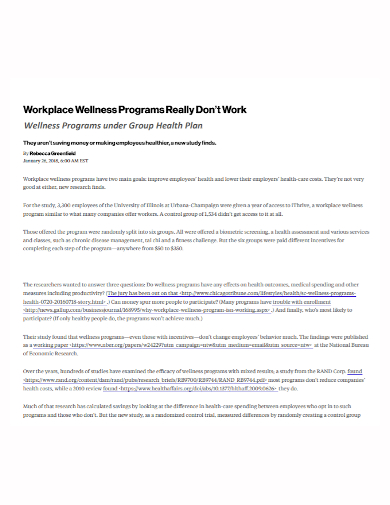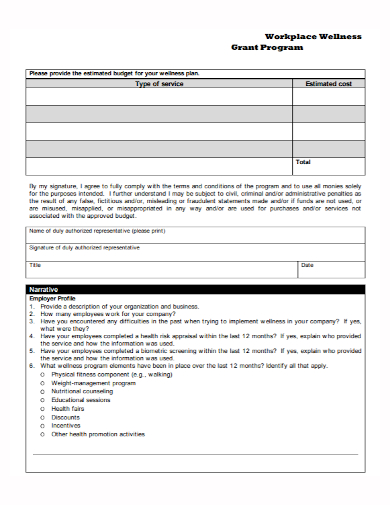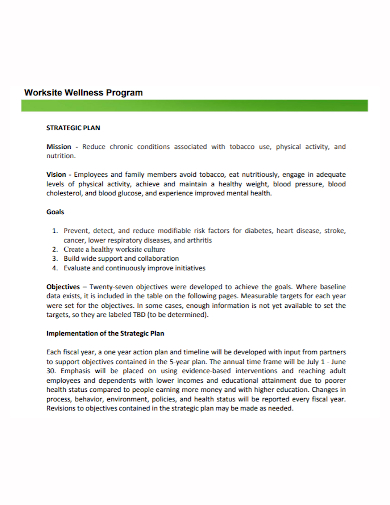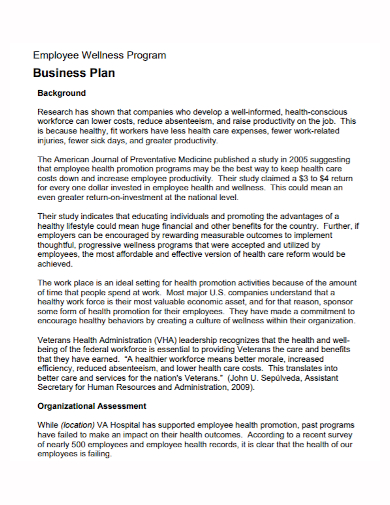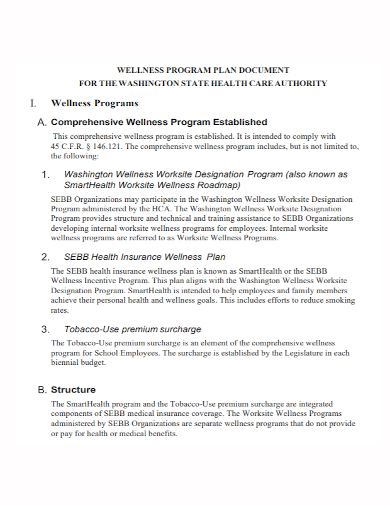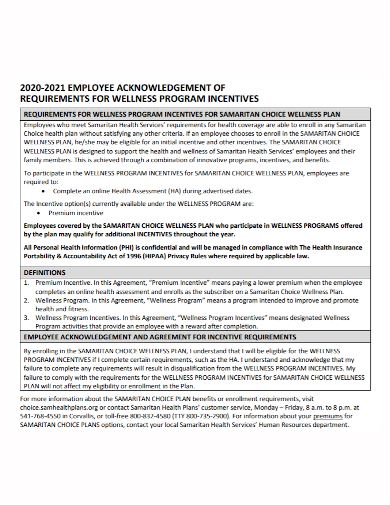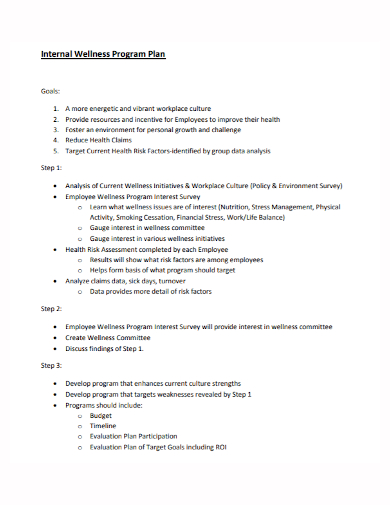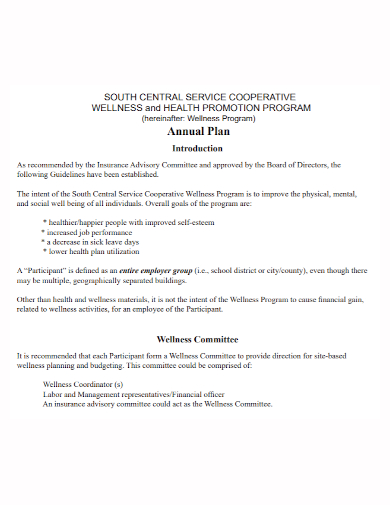Employees are offered wellness programs as a preventative measure to help them avoid illness while also improving and maintaining their overall health. Education, communication, and a positive work environment can all help to achieve this. Smoking cessation, weight loss, stress reduction, company gym/workout rooms, recreational programs such as company-sponsored sports teams, medical screenings, and immunization/flu shots are all common benefits of a wellness program. Educational safety and accident prevention programs are also included, which provide information and guidance on topics like back care, cancer prevention, and AIDS awareness, as well as proper eating and exercise habits. All of these benefits can be incorporated into an employer’s employee assistance program or offered separately.
10+ Wellness Program Plan Samples
Designing and implementing an employee wellness program is a critical step toward improving employee health and productivity while also potentially lowering the overall cost of employer-provided health care. Employers should consider developing and implementing a well-thought-out wellness program that ultimately benefits both the employee’s health and the employer’s bottom line, given the rising costs of health insurance and the significance of employee health.
1. Wellness Program Plan Template
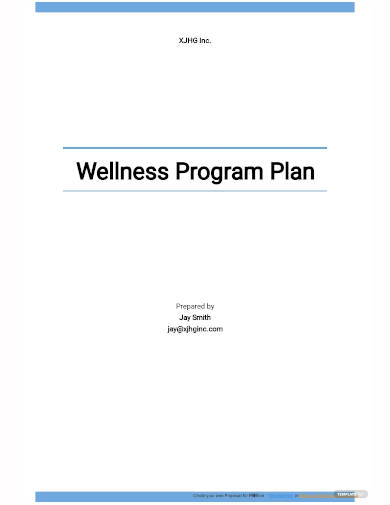
2. Workplace Wellness Program Plan
3. Workplace Wellness Grant Program Plan
4. Workplace Health and Wellness Program Plan
5. Worksite Wellness Program Strategic Plan
6. Employee Wellness Program Business Plan
7. Wellness Health Care Program Plan
8. Wellness Program Incentive Plan
9. Wellness Program Work Plan
10. Internal Wellness Program Plan
11. Wellness Program Annual Plan
Establishing a Wellness Program
- Conduct assessments – Acquiring information on the health of the workforce, as well as the organization’s willingness to improve based on that information, is a crucial step towards developing a staff wellness program. With this information, the employer will be able to create programs and services that benefit both the employer and the employee.
- Obtain management support – Building a successful wellness program requires management’s support. Management buy-in is essential for obtaining funding, gaining support throughout the organization, and approving policies and processes related to the program, as it is for any initiative. Management can lend a hand by assisting in the connection of health promotion goals to business outcomes, thereby establishing wellness as an integral part of the organization. Discussing the potential value of a wellness program to the organization’s bottom line is a challenge in gaining management support.
- Establish a wellness committee -An employer can create an internal, employee-driven committee to help build and sustain a wellness culture in the organization after determining the needs and obtaining management support. This committee will assist the wellness program in gaining organizational support and effectiveness. The wellness committee’s responsibilities may include the following:- Assessing the current programs, services, and policies in place at the workplace.
– Analyzing the needs and preferences of employees.
– Creating a health promotion operating plan, which includes a vision statement, as well as goals and objectives.
– Assisting with the planning, implementation, and evaluation of wellness activities. - Develop goals and objectives – Employers can set goals and objectives for the program based on the information gathered from the workforce assessment. For many businesses, improving employee health and lowering healthcare costs is a top priority. Other objectives could include lowering absenteeism, increasing worker productivity, and increasing employee retention. The goals and objectives of a wellness program are statements of the program’s broad, long-term accomplishments. Each goal has one or more objectives that must be met for the goal to be achieved. Clear, time-limited objectives should be stated in such a way that it is easy to determine whether they have been met.
- Establish a budget – To create a wellness program, you must first create a budget. The program will come to a halt if it does not receive funding. When putting together a wellness budget, companies should factor in the costs of incentives, marketing, and program design. Fees for screening vendors/other providers; incentives for participation; marketing materials; meeting provisions; pedometers/fitness trackers; HR representative and committee member time; and so on are typical budget items.
- Design the wellness program components – Employers have a lot of leeways when it comes to designing a wellness program. There is no one-size-fits-all solution because each program is tailored to the needs and resources of the organization. The wellness program can be as simple as a one-time event or as complex as a multi-year program. It is critical to include a variety of components that target risk behaviors as well as employee needs and interests. Organizations can use the resources gathered in previous steps of organizational assessment, wellness committee data collection, budgetary constraints, and goals and objectives, as well as the resources gathered in previous steps of organizational assessment, to determine the types of wellness programs to include in the design.
- Select wellness program incentives – Incentives or rewards are a powerful tool for changing unhealthy habits, maintaining healthy habits, increasing participation rates, and assisting individuals in completing a program. The case for rewarding employees for participating in a wellness program is based on basic behavioral psychology principles: people are motivated to act by the expected positive outcomes of their actions. A wellness program with a rewards system is a great motivator. Rewards can come in a variety of forms, such as points that can be exchanged for goods, gifts to commemorate achievements, or monetary awards. The motivation for rewards changes over time, shifting from an external incentive to intrinsic reinforcement.
- Communicate the wellness plan – The organization’s wellness policy must then be written and communicated. Concerning employee wellness, this policy statement should include the organization’s intention, level of participation, and rewards and incentives system.
- Evaluation – Evaluating the effectiveness of the wellness program, like any other investment or project, is critical to maintaining management and employee support as well as revising or implementing new programs. At the start of any wellness initiative, employers should have established metrics and baselines, which will vary depending on the programs implemented.
FAQs
Who is responsible for promoting the program?
A wellness committee is in charge of publicizing the program, organizing activities, communicating with management and employees, and assisting with program evaluation. The committee’s size and composition will be determined by the size of your company and the scope of the program.
Are meetings still necessary when conducting a wellness program?
At least once a quarter, the wellness committee should meet. When planning or implementing activities or programs, the committee may meet more frequently. The frequency of meetings will be determined by the committee’s objectives. Make membership on the wellness committee a one- or two-year commitment to ensure that new ideas and constituents are included on a rotating basis. The committee should establish a communication channel with management so that accomplishments can be shared.
If you want to see more samples and formats, check out some wellness program plan samples and templates provided in the article for your reference.
Related Posts
FREE 7+ Fashion Business Plan Samples in PDF
FREE 10+ Sprint Planning Samples In MS Word | Google Docs | PDF
FREE 10+ Wedding Planning Samples in MS Word | Apple Pages | Powerpoint | PDF
FREE 9+ Monthly Study Planner Samples in PSD | Illustrator | InDesign | PDF
FREE 9+ Sample Curriculum Planning Templates in PDF | MS Word
FREE 10+ Teacher Development Plan Samples in MS Word | Google Docs | Apple Pages | PDF
FREE 10+ Basketball Practice Plan Samples in PDF
FREE 12+ School Business Plan Samples in PDF | MS Word | Apple Pages | Google Docs
FREE 7+ Client Strategic Plan Samples in PDF | MS Word
FREE 11+ Trucking Business Plan Templates in PDF | MS Word | Google Docs | Pages
FREE 7+ Small Hotel Business Plan Samples PDF | MS Word | Apple Pages | Google Docs
FREE 14+ Bakery Business Plans in MS Word | PDF | Google Docs | Pages
FREE 4+ Yearly Lesson Plan Samples in PDF
FREE 50+ Strategic Planning Samples in Google Docs | Pages | PDF | MS Word
FREE 10+ Construction Project Plan Samples in MS Word | Google Docs | Apple Pages | PDF

